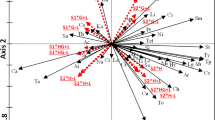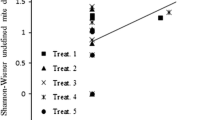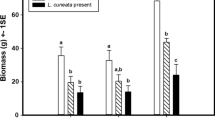Abstract
Knowledge of the complex interactions among trees, crops and their associated fauna is necessary to determine the viability of a particular agroforestry practice. Information is lacking concerning these interactions, particularly in temperate agroforestry practices. We examined the effects of two forages on the growth, nut production, and arthropod communities of alley cropped eastern black walnut, Juglans nigra L. Experimental plots of eastern black walnut, intercropped with alfalfa, Medicago sativa L., smooth bromegrass, Bromis inermis Leyss., or no vegetation were sampled with sweep nets prior to each cutting date for the forages. Comparisons were made between treatments and sampling dates. Tree growth measurements, nut yield and other nut quality measurements were taken at the end of each growing season. There were no differences in tree growth among alleyway treatments. The first season's nut yield was greater from trees with vegetation-free alleyways; otherwise nut production did not differ among the treatments. Arthropods were more numerous and diverse in alley cropped alfalfa than in alley cropped bromegrass or in the vegetation-free controls. Alley cropped bromegrass supported a more diverse population of arthropods than did the vegetation-free control. Arthropod diversity in the tree canopies did not differ among treatments. Alley cropped forages supported a more diverse and even arthropod fauna than did adjacent monocropped forages. We conclude that alley cropped forages had a relatively minor impact on the growth and nut yield of walnut trees.
Similar content being viewed by others
References
Andow D.A. 1991. Vegetational diversity and arthropod population respose. Annu Rev Entomol 36: 561-568.
Baliddawa C.W. 1985. Plant species diversity and crop pest control. Insect Sci Applic 6(4): 479-487.
Benjamin T.J., Hoover W.L., Seifert J.R. and Gillespie A.R. 2000. Defining competition vectors in a temperate alley cropping system in the Midwestern USA: 4. The economic return of ecological knowledge. Agrofor Syst 48: 79-93.
Basset Y. and Burckhardt D. 1992. Abundance, species richness, host utilization and host specificity of insect folivores from a woodland site, with particular reference to host architecture. Revue suisse Zool 99: 771-791.
Bloszyk E., Nawrot J., Harmatha J., Drozdz B. and Chmielewicz Z. 1990. Effectiveness of antifeedants of plant origin in protection of packaging materials against storage insects. J Appl Entomol 110: 96-100.
Funk D.T. 1979. Black walnuts for nuts and timber. In: Jaynes R.A. (ed.), Nut Tree Culture in North America. Northern Nut Growers Association, Inc, Hamden CT, pp. 51-73.
Garrett H.E. and Buck L.E. 1997. Agroforestry practice and policy in the United States of America. For Ecol Manage 91: 5-15.
Garrett H.E. and Jones J.E. 1993. Black walnut (Juglans nigra L.) agroforestry as a land-use alternative. North Nut Growers Assoc Ann Rep 84: 47-58.
Gillespie A.R., Jose S., Mengel D.B., Hoover W.L., Pope P.E., Seifert J.R. et al. 2000. Defining competition vectors in a temperate alley cropping system in the midwestern USA: 1. Production physiology. Agrofor Syst 48: 25-40.
Jones J.E., Garrett H.E., Haines J. and Loewenstein E.F. 1995. Genetic selection and fertilization provide increased nut production under walnut-agroforestry management. Agrofor Syst 29: 265-273.
Jose S., Gillespie A.R., Seifert J.R. and Biehle D.J. 2000a. Defining competition vectors in a temperate alley cropping system in the midwestern USA: 2. Competition for water. Agrofor Syst 48: 41-59.
Jose S., Gillespie A.R., Seifert J.R., Mengel D.B. and Pope P.E. 2000b. Defining competition vectors in a temperate alley cropping system in the midwestern USA: 3. Competition for nitrogen and litter decomposition dynamics. Agrofor Syst 48: 60-77.
Kearby W.H. 1975. insects that affect the growth and form of black walnut in a multicrop system. North Nut Grower Assoc Annu Rep 66: 119-127.
Lawton J.H. 1978. Host-plant influences on insect diversity: the effects of space and time. In: Mound L.A. and Waloff N. (eds), Diversity of insect faunas. Blackwell Scientific Publications, Oxford, UK, pp. 105-125.
Lawton J.H. and Schroder D. 1977. Effects of plant type, size of geographical range and taxonomic isolation on number of insect species associated with British plants. Nature 265: 137-140.
Magurran A.E. 1988. Ecological Diversity and Its Measurement. systems. For Ecol Manage 45: 5-29.
Pimentel D. and Wheeler A.G. 1972. Species and diversity of arthropods in the alfalfa community. Environ Entomol 2(4): 659-668.
Rule L.C., Colletti J.P., Liu T.P., Jungst S.E., Mize C.W. and Schultz R.C. 1994. Agroforestry and forestry-related practices in the Midwestern United States. Agrofor Syst 27: 79-88.
Stamps W.T. and Linit M.J. 1998. Plant diversity and arthropod communities: Implications for temperate agroforestry. Agrofor Syst 39: 73-89.
SAS Institute 1992. SAS User's Guide: Statistics. 6th edn. SAS Institute, Cary, NC, 705 pp.
Smith M.W., Arnold D.C., Eikenbary R.D., Rice N.R., Shiferaw A., Cheary B.S. et al. 1996a. Influence of ground cover on beneficial arthropods in pecan. Bio Control 6: 164-176.
Smith M.W., Arnold D.C., Eikenbary R.D., Rice N.R., Shiferaw A., Cheary B.S. et al. 1996b. Influence of ground cover on phytophagous and saprophagous arthropods in pecan trees. South-west Entomol 21: 303-316.
Strong D.R. and Levin D.A. 1979. Species richness of plant parasites and growth form of their hosts. Amer Nat 14:1-22.
Van Sambeek J.W. 1985. Intercropping black walnu. North Nut Grow Annu Rep 76: 157-162.
Williams P.A. and Gordon A.M. 1992. The potential of intercropping as an alternative land use system in temperate North America. Agrofor Syst 19: 253-263.
Williams P.A. and Gordon A.M. 1995. Microclimate and soil moisture effects of three intercrops on the rows of a newly-newly planted intercropped plantation. Agrofor Syst 29: 285-302.
Wyss E. 1996. The effects of artificial weed strips on diversity and abundance of arthropod fauna in a Swiss experimental apple orchard. Agric Ecosys Environ 60: 47-59.
Author information
Authors and Affiliations
Corresponding author
Rights and permissions
About this article
Cite this article
Stamps, W.T., Woods, T.W., Linit, M.J. et al. Arthropod diversity in alley cropped black walnut (Juglans nigra L.) stands in eastern Missouri, USA. Agroforestry Systems 56, 167–175 (2002). https://doi.org/10.1023/A:1021319628004
Issue Date:
DOI: https://doi.org/10.1023/A:1021319628004




